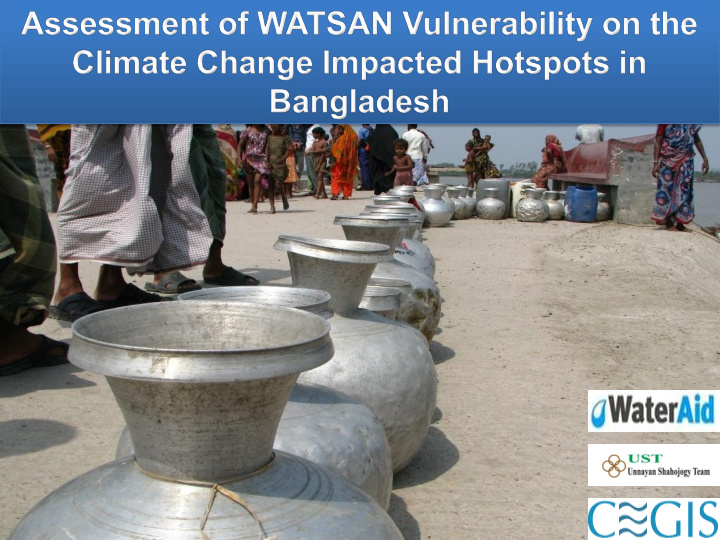



Identify natural hazards which have impacts on Water Supply and Sanitation Determine WATSAN status in Bangladesh Assessing impacts of natural hazards Formulate adaptation strategies to face climate challenges on WATSAN
Hydrologic No. of upazila Region North West 122 Region North Central 65 Region Extended North 93 East Region Extended Coastal 178 Region Eastern Hill 25
Monsoon flood Storm surge Rainfall Stress Salinity intrusion Riverbank erosion
97.8 % of the population used an improved drinking water source In urban areas, the rate was 99.5 % and in rural areas 97.4 %.
Threats of natural hazards like flood, storm surge, salinity intrusion in surface water, river erosion which will increase in future due to climate change Safe water scarcity due to water logging during 5-6 months in some years Lowering of ground water level during dry season which affect the availability of groundwater from shallow tube wells Pollution of water bodies
According to BBS, 2011 63 % households have hygienic latrine 29% households have un-hygienic latrine 8% have no latrines
Natural hazard like floods, storm surge, river erosion, and socio-economic problems like poverty, illiteracy, food scarcity, gender issues etc. Scarcity of water in some areas for installing sanitary latrine Pollution of water bodies due to open defecation Lack of appropriate and sustainable technical solution regarding sanitation Lack of awareness on sanitation and hygiene issues Absence of sanitation management plan
R dry <380mm in 2050 (Mukherjee et al. , 2011) 13% increase in 2050 (World Bank, 2010)
17.5% more area in 2050 (>or=1ppt) (IWM & CEGIS, 2007)
18% more area in 2050 (World Bank, 2010)
Integrated Risk Assessment Physical Risk Socio-economic Risk Proportion of women Scoring of upazila due to hazards Proportion of dependent people Weightage of hazard in particular region Proportion of poor/unprivileged group
Natural isk Assessment (Base Scenario) Region Risk Rank Affected Upazillas North High 0 West Medium 81 Region Low 45 North High 0 Central Medium 77 Region Low 21 Extended High 0 North East Medium 69 Region Low 23 Extended High 64 Coastal Medium 92 Zone Low 36
Region Risk Rank Affected Upazillas North West High 0 Region Medium 106 Low 20 North High 0 Central Medium 76 Region Low 22 Extended High 0 North East Medium 61 Region Low 31 Extended High 71 Coastal Zone Medium 74 Low 47
Socio-economic Risk Assessment (Base Scenario) Female/Gender Ratio Poor/Underprivileged Dependent group -Aged -Children -Pregnant Woman
Risk level Population (%) Area (%) Very High 5.78 8.85 High 31.16 28.57 Medium 44.55 38.90 Low 15.88 16.92 Very Low 2.62 6.74
• To cope with the situation adaptive measures and programs should be formulated carefully and effectively. • Adaptive measures should aim at sustainable water supply options for future needs. Adaptation options discussed in two broad categories • Management oriented • Technological based
Non structural adaptation measures • Institutional strengthening • Community participation and awareness • Women’s Empowerment • Reuse and efficient use of water • Water resources assessment
Technological Options Area of application Region Piped System Flood, Storm surge, NW, ENE, ECZ, NC, Salinity intrusion, Water EH (parts) scarce areas Raised Deep Tubewells Flood, Storm surge ENE, ECZ, NW (parts) Rainwater Harvesting Scheme Flood, Storm surge, ENE, ECZ, EH, NC (RHS) Salinity intrusion Pond Sand Filter (PSF) Salinity, Water scarce ECZ areas Gravity Feed System (GFS) Flood EH Infiltration Gallery Flood EH, ENE Tara pump no 6 Flood, Water scarce areas NW, ENE, EH Very Shrouded Shallow Salinity ECZ Tubewell (VSST) Protected Dug well Flood, Storm surge ENE, ECZ (except tidal zone) Spring/Ghiri Flood EH
• Inadequate sanitation will be more challenging in context of the impact of climate change. • Integration of technological innovation, strong community involvement and management strategies • Adaptation options for sanitation have been discussed under two broad categories: • Management related adaptation • Technological adaptation
Institutional Strengthening Community Involvement Focus on Women and Gender Issues
Technological Area of application Region Cost Options Earth Stabilised Raised Flood, Storm surge ENE, NW, NC, Low to Pit Latrine ECZ medium Step Latrine Flood, Storm surge ENE, NW, NC, Low to ECZ medium Mound Latrine Flood, Storm surge NE, NW, NC, Low to ECZ medium Sand Enveloped Latrine High-water table ENE, ECZ Low to areas medium Sand Enveloped Raised Flood, storm surge ENE, ECZ Medium Latrine and High-water table areas Community latrine Flood and storm All regions Low to surge medium
Impact of Climate Change on Ground Water quantity & quality (salinity) Relationship between GW replenishment and rainfall Refinement of location specific Climate Change Impact
Recommend
More recommend